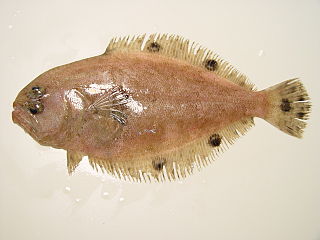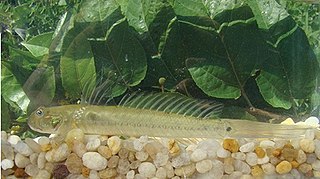
Flounders are a group of flatfish species. They are demersal fish, found at the bottom of oceans around the world; some species will also enter estuaries.

Citharichthys is a genus of flatfish in the large-tooth flounder family, Paralichthyidae. They have both eyes on the left sides of their heads. They are native to the oceans around the Americas, with a single species, C. stampflii off the West African coast. Most are found in relatively shallow depths, but the genus also includes species found in deep water and species that enter fresh water.

The California halibut or California flounder is a large-tooth flounder native to the waters of the Pacific Coast of North America from the Quillayute River in Washington to Magdalena Bay in Baja California. It feeds near shore and is free swimming. It typically weighs 6 to 30 pounds. It is much smaller than the larger and more northern-ranging Pacific halibut that can reach 300 pounds (140 kg).

Pseudopleuronectes is a genus of righteye flounders mostly native to the northwestern Pacific Ocean with one species (P. americanus) found in the northwestern Atlantic Ocean.

Poecilopsetta is a genus of small righteye flounders mainly found in deep water in the Indo-Pacific. Two species, P. beanii and P. inermis, are from the West Atlantic.

The harborseal, also known as the common seal, is a true seal found along temperate and Arctic marine coastlines of the Northern Hemisphere. The most widely distributed species of pinniped, they are found in coastal waters of the northern Atlantic and Pacific Oceans and the Baltic and North Seas.
P. californicus may refer to:

Bothus is a genus of flatfish in the family Bothidae from the Pacific, Indian and Atlantic Oceans. Some species in this genus have spots consisting of blue rings.

Daector is a genus of toadfishes, with three species found along the Pacific Coast of Central America and two species, D. gerringi and D. quadrizonatus, are found in South American rivers.

The scaldfishes comprise a genus, Arnoglossus, of lefteye flounders. They are found in the Pacific, Indian and Atlantic Oceans, including the Mediterranean and Black Sea. They are entirely absent from most of the Americas; the only exceptions are A. coeruleosticta and A. multirastris found off Chile. The genus include both species found in shallow and deeper water. The largest species reaches 28 cm (11 in).

Crossorhombus is a genus of small lefteye flounders native to the Indian and West Pacific Oceans.
Engyophrys is a genus of small lefteye flounders native to the oceans around the Americas.
Perissias taeniopterus, the striped-fin flounder, is a species of lefteye flounder native to the eastern Pacific Ocean along the coast of Central America from Mexico to Panama. It is found at depths of from 46 to 157 metres. This species grows to a length of 11 centimetres (4.3 in) TL. This species is the only known member of its genus.

Ancylopsetta is a genus of large-tooth flounders mostly found along the Atlantic coast of the Americas with one species found along the Pacific coast.

Cyclopsetta is a genus of large-tooth flounders native to the coastal waters of the Americas.

Etropus is a genus of large-tooth flounders native to the coastal waters of the Americas.

Hippoglossina is a genus of large-tooth flounders native to the coastal Pacific waters of the Americas. A single species, H. oblonga is found along the Atlantic coast of United States and Canada, but it is frequently placed in Paralichthys instead of Hippoglossina.

Paralichthys is a genus of large-tooth flounders. Most species are native to the coastal waters of the Americas, but P. olivaceus is from northeast Asia. The largest species reaches about 1.5 m (5 ft) in length.

Syacium is a genus of large-tooth flounders found in the Atlantic and Pacific Oceans. With the exception of S. guineensis from the Atlantic coast of Africa, all species are from the Americas. The largest species in the genus reaches 40 cm (16 in) in length.

Gobionellus is a genus of gobies native to fresh, marine and brackish waters along the Atlantic and Pacific coasts of the Americas.



















